中等溶剂沉淀与溶剂分解相结合的粉末床熔融用老化聚酰胺12原料的闭环回收方法
IF 10.3
1区 工程技术
Q1 ENGINEERING, MANUFACTURING
引用次数: 0
摘要
聚酰胺是最常用的粉末,在粉末床熔融(PBF)工艺中,一个主要的挑战是如何处理已经使用过的粉末(老化粉末)。在PBF过程中,聚酰胺粉末经历化学老化,导致原料材料的热学和流变性能发生改变。用老化粉末制成的部件质量较差。因此,陈年粉通常用新(初)粉来更新。但是,在加工过程中会积累大量的老化粉末。这些多余的数量要么用于其他塑料制造过程(降级循环),要么更频繁地处理掉。采用溶剂溶解与随后的热诱导液液相分离和聚合物结晶(TIPS+S)相结合的工艺来恢复老化聚酰胺12 (PA12)的热性能和流变性能,从而使粉末再次适合PBF。老化PA12的溶解程度可通过反应温度或反应时间来调节。动力学模型允许根据进料的老化条件确定合适的TIPS+S工艺参数,以使回收的PA12粉末的热性能与未加工的PA12粉末的热性能相匹配。优化后的再生PA12粉末具有与原始材料相当的零剪切粘度、粒径分布、颗粒形状和流动性。由同样混合的再生和老化的PA12粉末制成的样品获得了与同样混合的原始和老化粉末的PBF相同的力学性能。因此,闭环回收方法是可行的,其中PBF工艺中老化的PA12粉末通过所提出的TIPS+S工艺回收。本文章由计算机程序翻译,如有差异,请以英文原文为准。
Closed loop recycling approach for aged polyamide 12 feedstocks for powder bed fusion by precipitation from a moderate solvent combined with solvolysis
A major challenge in the powder bed fusion (PBF) process with polyamides, which are the most commonly used powders, is the handling of already used powder (aged powder). During PBF, polyamide powders undergo chemical ageing, resulting in altered thermal and rheological properties of the feedstock material. Components made from aged powder are of inferior quality. Therefore, aged powder is usually refreshed with new (virgin) powder. Although, a substantial amount of aged powder accumulates over the course of processing. These excess quantities are either employed in other plastic manufacturing processes (downcycling) or, more frequently, disposed. A combined process of solvolysis with subsequent thermally induced liquid-liquid phase separation and polymer crystallisation (TIPS+S) is used to restore the thermal properties and rheological properties of aged polyamide 12 (PA12) and thus to make the powders suitable for PBF again. The degree of solvolysis of the aged PA12 is tuned by reaction temperature or reaction time. A kinetic model allows to determine suitable process parameters for TIPS+S depending on the ageing condition of the feed to match the thermal properties of the recycled PA12 powders to those of PA12 virgin powder. The optimised recycled PA12 powder shows comparable zero shear viscosity, particle size distribution, particle shape and flowability to the virgin material. Specimen built from equally mixed recycled and aged PA12 powder achieved the same mechanical properties like those obtain by PBF of equally mixed virgin and aged powder. Therefore, a closed loop recycling approach is feasible, in which aged PA12 powders from the PBF process are recycled by the proposed TIPS+S process.
求助全文
通过发布文献求助,成功后即可免费获取论文全文。
去求助
来源期刊

Additive manufacturing
Materials Science-General Materials Science
CiteScore
19.80
自引率
12.70%
发文量
648
审稿时长
35 days
期刊介绍:
Additive Manufacturing stands as a peer-reviewed journal dedicated to delivering high-quality research papers and reviews in the field of additive manufacturing, serving both academia and industry leaders. The journal's objective is to recognize the innovative essence of additive manufacturing and its diverse applications, providing a comprehensive overview of current developments and future prospects.
The transformative potential of additive manufacturing technologies in product design and manufacturing is poised to disrupt traditional approaches. In response to this paradigm shift, a distinctive and comprehensive publication outlet was essential. Additive Manufacturing fulfills this need, offering a platform for engineers, materials scientists, and practitioners across academia and various industries to document and share innovations in these evolving technologies.
 求助内容:
求助内容: 应助结果提醒方式:
应助结果提醒方式:


